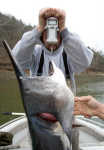- Missouri campgrounds resurgence (5/30/20)
- August a fantastic month for catfishing (8/11/18)
- Kayaking, canoeing good way to spend hot summer days (7/27/18)
- Hot weather means hot catfishing (7/7/18)
- Boat buyers have abundant options (6/16/18)
- Warm weather invites camping (6/9/18)
- Topwater fishing is a blast (6/2/18)
Hard to hook: Spring spoonbill season underway
Saturday, March 28, 2015

Photo courtesy of the Missouri Department of Conservation/
A big spoonbill being weighed by a successful angler.
Nevada Daily Mail
Whether you call it paddlefish, spoonbill, or shevelnose-cat, the snagging season for this living fossil began in Missouri on March 15.
One of North America's largest freshwater fish will not take bait or lures, but must be snagged or grabbed with a hook, if an angler wants to catch one.

Photo courtesy of the Missouri Department of Conservation/
An early weekend morning found boats with anglers after spoonbills. Fishing for these prehistoric fish was good as the fish start their spawning run.
The spring spoonbill snagging season has long been a popular sport on the Osage River neat Osceola. Conservation agent for St. Clair County, Joni Bledsoe said, "It's a popular activity in our area."
Even with the construction of the Truman Dam prior to the late 1980s, the Osage River was a leading spoonbill fishery. Robert Wenie, Garden City, has fished the Osage near Osceola for 47 years and hooked an 85 pound spoonbill last weekend. He said several years ago he caught his largest fish, a spoonbill that weighed more than 100 pounds. He fishes in the same spot, from the bank near the park in Osceola. While boats cruise up and down the river Winie hooks his fish by casting from the bank.
Fishing from the bank near Winie, was William Watskey, Kansas City, who was fishing from the bank for the first time on the Osage. He snagged a 40 pound fish and after a short battle, he landed the big fish.

Ken White/Daily Mail/
Jim Nicholas and son, Clinton, with a pair of spoonbills they hooked while casting hooks in the Osage River last weekend.
He said, I wasn't very hopeful that the fishing would be good after hearing reports that the water was too cold for the fish to start moving up to their spawning grounds, but I saw several people with some big fish and it was a great day to be out."
Since the spoonbill is not attracted to baits, blindly snagging the fish is the only legal method for catching this preshistoric fish.
The snagging methods effectiveness depends on the presence of large numbers of fish in a confined area when the fish are concentrated on their spawning grounds.

Ken White/Daily Mail/
Robert Wenie, Garden City, left, holds up an 85 pound spoonbill he hooked on the Osage River near Osceola. William Watskey, Kansas City, holds a smaller fish he snagged. Both anglers were casting hooks from the bank.
Snaggers use large, heavy deep-sea rods or home-made rods. Others prefer hoe and pitchfork handles. The rods are fitted with strong reels, heavy line, one or two treble hooks and heavy weight. The line, with unbaited hooks are thrown into the river then reeled back through the water until a spoonbill is snagged.
Winie recalls how much the snagging on the Osage has changed. He said, " Before Truman dam was constructed, bank fishing was popular, but today most people fish from boats. I still fish from the bank in the same spot and have taken some big fish."
While Winie was holding up his catch, a boat pulled into shore with Jim Nichols, Ash Grove, who is a former Osceola resident, and his seven-year-old son, Clinton. They had snagged two legal fish and said they had seen other fishermen pulling in some big fish. " It was a good day to be on the water," Nichols said.
The two outstanding features of this fish are its long, paddle-shaped snout and its boneless skeleton. The long flattened snout may take up to one-third on its overall length. The skeleton is made entirely of cartilage. In addition, the fish is almost scaleless, with only a few small scales on the tail.
For most of its life, the spoonbill inhabits slow moving waters that are rich in microscopic life. During the spawning season it moves to fast flowing rivers.
The season for snagging spoonbills runs from March 15 to April 30. As with any game fish, there are restrictions on the size and number of fish that can be taken.

